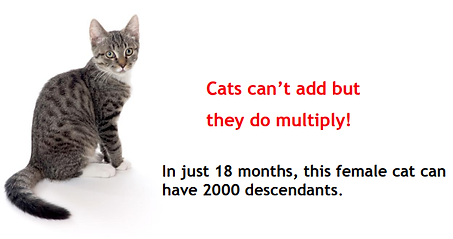Example Activity: Having Kittens
Explore a Lesson from the Mathematics Assessment Project
The Task
The Having Kittens activity asks students to determine if a female cat can have 2000 descendants in 18 months. While this may initially sound like a fairly straightforward task, it is actually a complex situation to consider, with multiple solution paths possible. As students work to build their models they must consider which of the provided facts they will use, explore possible additional variables, and discuss implications that these have for the strength of their models.



This task was designed by the Mathematics Assessment Project, which also provides lesson guides, PowerPoint slides, potential student solutions, and other resources for educators. While approximately 140 minutes of class time is recommended for this lesson, modifications can help to reduce the time needed.
An Activity to Start Modeling
Unlike a truly open mathematical modeling lesson, this task starts by providing an initial problem and constraints for students to consider. This structure limits solution path options, helping to provide a foothold for students as they begin creating their models and a way for teachers to begin implementing modeling activities without becoming overwhelmed. This structure does not overly restrict student creativity however. Even though constraints about cats’ reproductive cycle are provided, students must decide which constraints they will utilize and there is room for students to consider additional factors. The authors also do not provide a clear criteria for what would be considered an “unreasonable” estimate of the population after 18 months, but leave this up to the creators of the model.
These opportunities enable students to experience the open nature of mathematical modeling tasks by giving them a level of autonomy. They provide a general guide and offer a support for students to use to progress, but they do not guide them to a predetermined path. Despite the initial limitation of student discretion in the process, this modeling activity provides “the student with opportunities to express his (or her) own way of thinking so that those ways can be shared, tested, revised and refined” (Lesh et al., 2003, p. 228).
Model Development: Student & Teacher Activity
The iterative and reflective nature of mathematical modeling tasks can be seen as students work to develop their solutions. Students working on the task are asked to go through a cycle of posing questions, building solutions, and validating their conclusions (Carlson et al., 2016). There is no guidance provided for how to proceed, students must direct their activities in a way that they feel will help them come to a valid solution through decisions that support their goal and appropriately model the situation. They must reflect upon their decisions in order to better understand the implications they introduce and refine their models (de Carvalho Borba et al., 2016; Maiorca & Stohlmann, 2016).
Throughout this process teachers can provide support by posing questions that facilitate communication, prompt discussion, compare approaches, assist student reflection, or balance the mathematical demand of the situation (Carlson et al., 2016). While students should not be led during the modeling process (Gann et al., 2016; Stender & Kaiser, 2016), questions can be posed to provoke deeper thought. Informal opportunities to check student understanding through discussions or periodic reporting from groups can also provide a valuable opportunities to support students as they create their models (Reins, 2016).
Once students have developed their models and come to a conclusion, they are asked to share with the class. This continues the process of model evaluation, exposing students to different perspectives, which can help them reflect on their chosen methods and the methods of others. Ideally this would be followed by an opportunity to revisit the activity (Carlson et al., 2016). This helps students build on their previous models, revising and refining them with new mathematical and contextual ideas (Carlson et al., 2016).
References
Carlson, M., Wickstrom M., Burroughs E., & Fulton, E. (2016). A case for mathematical modeling in the elementary school classroom. In C. R. Hirsch & A. R. McDuffie (Eds.), Mathematical modeling and modeling mathematics (pp. 121-130). National Council of Teachers of Mathematics.
de Carvalho Borba, M., Villarreal, M., & da Silva Soares, D. (2016). Modeling using data available on the internet. In C. R. Hirsch & A. R. McDuffie (Eds.), Mathematical modeling and modeling mathematics (pp. 143-152). National Council of Teachers of Mathematics.
Gann, C., Avineri, T., Graves, J., Hernandez, M., & Teague, D. (2016). Moving students from remembering to thinking: The power of mathematical modeling.
In C. R. Hirsch & A. R. McDuffie (Eds.), Mathematical modeling and modeling mathematics (pp. 97-106). National Council of Teachers of Mathematics.
Lesh, R., Doerr, H. M., Carmona, G., & Hjalmarson, M. (2003). Beyond Constructivism. Mathematical Thinking and Learning, 5(2–3), 211–233.
Maiorca, C., & Stohlmann, M. (2016). Inspiring students in integrated STEM education through modeling activities. In C. R. Hirsch & A. R. McDuffie (Eds.), Mathematical modeling and modeling mathematics (pp. 153-162). National Council of Teachers of Mathematics.
Reins, K. (2016). Broadening the landscape of modeling by including an emergent view. In C. R. Hirsch & A. R. McDuffie (Eds.), Mathematical modeling and modeling mathematics (pp. 77-85). National Council of Teachers of Mathematics.